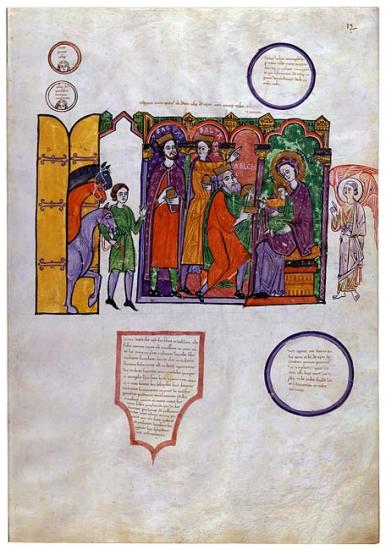
Genealogical Tables: Christ's Direct Ancestors And The Adoration Of The Magi
Beatus of Liébana
Las Huelgas Apocalypse
Purchased by Pierpont Morgan, 1910
The last tables cover the period from the Babylonian Exile to the Incarnation of Christ. At the top of the last table, in the two small unconnected roundels, we read Jacob genuit Josep (Jacob begat Joseph) and Josep disponsabit mariam virginem (Joseph betrothed to Virgin Mary). Below is Christ, on Mary's lap, adored by the Magi, an act symbolizing public recognition of the Savior. By the third century the Magi were redefined as kings, and by the ninth century they were given the familiar names of Caspar, Balthazar, and Melchior. The inscription in the circle below the Madonna states that the Lion of Judah, from the root of David, will conquer, and that to the left describes Christ's life and Passion, thus underscoring that the fruit of this genealogy will result in humanity's redemption.
The Apocalypse, or Book of Revelation, is not only the last Book of the New Testament, but its most difficult, puzzling, and terrifying. It provided challenges to medieval illustrators and was the source for a number of popular images, such as Christ in Majesty, the Adoration of the Lamb, and the Madonna of the Apocalypse and contributed to the widespread use of the Evangelists' symbols.
Selected images from Apocalypse Then: Medieval Illuminations from the Morgan, an exhibition held at the Morgan are presented here. The exhibition celebrates the completion of a facsimile of the Morgan's Las Huelgas Apocalypse—the latest dated (1220) and largest surviving manuscript of a Spanish tradition of illuminated commentaries on the Apocalypse by the monk Beatus of Liébana. The series of manuscripts constitutes Spain's most important contribution to medieval manuscript illumination.
The Las Huelgas Apocalypse contains three sections: the prefatory cycle, the Apocalypse, and the Book of Daniel.
In addition to forty-nine images from the Las Huelgas Apocalypse, six images from other manuscripts in the Morgan's collections, including the earliest Beatus painted by Maius and one by the Master of the Berry Apocalypse, are in this presentation.
